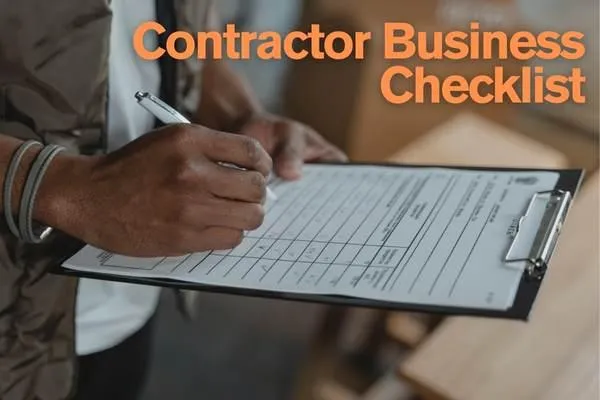
Ultimate Checklist for Starting a Contractor Business: 10 Steps to Success
Ultimate Checklist for Starting a Contractor Business: 10 Steps to Success
Starting a contractor business in California is one of the most rewarding paths for skilled tradespeople—but it’s also one of the most regulated. With over 240,000 licensed contractors overseen by the CSLB, competition is fierce and compliance is non-negotiable. To succeed, you need more than tools and experience—you need the right licenses, bonds, insurance, and strategy to grow your business and protect your clients.
This guide gives you the ultimate 10-step checklist for starting your contractor business in 2025, plus tailored tips for plumbers, roofers, electricians, landscapers, carpenters, HVAC contractors, and handymen.
1. Choose Your Business Structure
Your legal structure determines your liability protection and taxes:
Sole Proprietorship: Easy setup but no personal liability protection.
LLC: The most common choice for contractors—protects personal assets while remaining flexible.
Corporation: Best for large operations with multiple partners.
💡 Tip: Most new contractors prefer forming an LLC to protect personal assets in case of lawsuits or unpaid claims.
2. Register Your Business Name
Pick a professional name that clients will trust. If it differs from your legal name, file a Fictitious Business Name (FBN) in your county.
Make sure your business name matches CSLB records exactly to avoid licensing delays.
3. Apply for a Contractor’s License
In California, any project worth more than $500 requires a contractor’s license from the CSLB.
Steps include:
Submitting proof of 4 years’ journey-level experience.
Passing the Law & Trade exam.
Filing a $25,000 contractor license bond.
Paying state licensing fees.
👉 Learn more in our California Contractor License Bonds guide.
4. Secure Your Contractor License Bond
A $25,000 California contractor bond is mandatory for all contractors. This protects consumers, employees, and suppliers if you fail to meet state regulations or pay wages.
Other bonds may include:
Bond of Qualifying Individual (BQI) – $25,000 if your license is qualified by an RME/RMO.
$100,000 LLC Employee/Worker Bond – for LLC contractors.
👉 See our step-by-step Bonding Process for Contractors.
5. Obtain Contractor Insurance
Insurance isn’t just a safety net—it’s often a contract requirement.
Core coverages include:
General Liability Insurance – protects against property damage & injuries.
Workers’ Compensation – required if you hire employees.
Tools & Equipment Insurance – covers theft or damage to your gear.
Commercial Liability – crucial for small construction businesses.
👉 See the full California Contractor Insurance Guide.
6. Build a Financial System
Open a business bank account.
Set up accounting software to track expenses and payroll.
Budget for insurance premiums, bonds, and renewals.
7. Stay Compliant With Renewals
Your license, bond, and insurance must stay active.
CSLB licenses expire every 2 years.
Bonds must be renewed before expiration.
Insurance should always remain in force.
👉 See our California Contractor Insurance post for renewal tips.
8. Create a Marketing Strategy
To win contracts, you need visibility. Use:
A professional website.
Referrals and community involvement (see here).
9. Draft Strong Contracts
Contracts protect both you and your clients. Include:
Scope of work
Payment terms
Liability and insurance clauses
👉 Learn more about Contract Bonds.
10. Plan for Long-Term Growth
Invest in project management tools.
Build a network of subcontractors.
Consider advanced coverages like Pollution Liability or Contractor’s E&O Insurance.
📌 Insurance & Bond Requirements by Contractor Type
Different trades face unique risks. Here’s what California contractors need:
Plumbers
Risks: Water damage claims, faulty installation.
Required: General liability, workers’ comp (if employees), contractor bond.
Recommended: Completed operations coverage (for post-installation leaks).
Roofers
Risks: Falls, high workers’ comp rates, property damage.
Required: Contractor bond, general liability, workers’ comp.
Recommended: Tools & equipment insurance, umbrella liability.
Electricians
Risks: Fire hazards, injury from electrical work.
Required: Contractor bond, liability insurance, workers’ comp.
Recommended: Completed operations coverage (fire claims post-project).
HVAC Contractors
Risks: Faulty installations, employee injury, high-rise projects.
Required: Bond, liability, workers’ comp.
Recommended: Commercial auto (for service vans), tools coverage.
Carpenters
Risks: Property damage, saw injuries, subcontractor liability.
Required: Bond, general liability, workers’ comp.
Recommended: Inland marine insurance for mobile tools.
Landscapers
Risks: Equipment damage, client property damage, pesticide liability.
Required: Bond, liability, workers’ comp (if employees).
Recommended: Commercial auto, pollution liability coverage.
Handymen
Risks: Wide range of jobs, inconsistent coverage needs.
Required: Bond, general liability.
Recommended: Tools & equipment insurance, umbrella liability.
Final Thoughts
Starting a contractor business requires planning, compliance, and protection. By following this 10-step checklist and securing the right bonds and insurance, you’ll not only stay compliant with the CSLB but also build trust with clients and position your business for long-term success.
FAQs
1. How much is a California contractor bond in 2025?
The CSLB requires a $25,000 bond for all licensed contractors. Rates depend on credit, starting around $125 annually. 👉 See Bonding Process for Contractors.
2. Do handymen need a license?
Yes, if the project is over $500 in labor and materials, a CSLB license and bond are required.
3. Can I work without general liability insurance?
Legally yes, but most clients won’t hire you without it. 👉 See Contractor General Liability Insurance.
4. What happens if my bond lapses?
Your CSLB license is automatically suspended until the bond is reinstated.
5. Which contractors pay the highest insurance rates?
Roofers and general contractors usually pay the most due to higher accident risks.
👉 Next Step: Explore our Insurance Blog Hub for in-depth guides tailored to every contractor trade.

